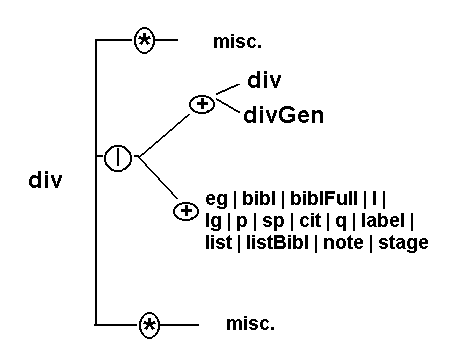![[The HTML Writers Guild Logo]](../../images/lo-025.gif)
The HTML Writers Guild

![[The HTML Writers Guild Logo]](../../images/lo-025.gif) |
|
||
This and the next page looks at the div* elements of the teixlite dtd. These elements are used for the major structuring of a document in TEI.
The element declaration for the div element appears below. Essentially this element is recursive and must contain either another div, or divGen element or one of the other structural elements such as a p element (See allowed content below). A simplified version appears in the figure below.
A divGen element is an empty element that is used to indicte the place where computer or application generated text is to be inserted.
div sections are usually further defined using the 'type' attribute, although the universal n attribute may also be used.

<!ELEMENT div ((argument | byline | docAuthor | docDate | epigraph | head | opener | salute | signed | index | interp | interpGrp | lb | milestone | pb | gap | anchor)*, (((div | divGen), (index | interp | interpGrp | lb | milestone | pb | gap | anchor)*)+ | (((eg | bibl | biblFull | l | lg | p | sp | cit | q | label | list | listBibl | note | stage), (index | interp | interpGrp | lb | milestone | pb | gap | anchor)*)+, ((div | divGen), (index | interp | interpGrp | lb | milestone | pb | gap | anchor)*)*)), ((byline | closer | epigraph | salute | signed | trailer), (index | interp | interpGrp | lb | milestone | pb | gap | anchor)*)*) > <!ELEMENT divGen EMPTY >
As you can see div elements can be nested to any level.
Many of the other elements have an obvious meaning. You are directed to the official documentation for the semantics of the other elements.
The next page shows how the non-recursive div* elements of TEI are used.